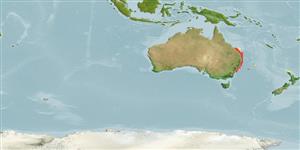Environment: milieu / climate zone / depth range / distribution range
Écologie
marin démersal; profondeur ? - 90 m (Ref. 27621). Tropical; 22°S - 35°S
Western Pacific: Rockhampton, Queensland to Port Jackson, New South Wales (Ref. 27621).
Taille / Poids / Âge
Maturity: Lm ? range ? - ? cm
Max length : 70.0 cm TL mâle / non sexé; (Ref. 27621); common length : 35.0 cm TL mâle / non sexé; (Ref. 27621); poids max. publié: 7.3 kg (Ref. 27621); âge max. reporté: 19 années (Ref. 96948)
Épines dorsales (Total): 8; Rayons mous dorsaux (Total): 11; Épines anales 3; Rayons mous anaux: 9. One dark vertical band through eye which may disappear with an increase in size; 11 dorsal fin rays and 9 anal fin rays. Supraclavicle (shoulder-bone) developed into a prominent bony shield.
Found in coastal waters in moderate depths to 90 m on the continental shelf particularly close to submerged reefs, rock ledges or rough bottom (Ref. 27621). This species is stated to be a midwater feeder (Ref. 27621). The inside of the mouth is black and may luminescent at night (Ref. 27621).
Life cycle and mating behavior
Maturité | Reproduction | Frai | Œufs | Fécondité | Larves
McKay, R.J., 1997. FAO Species Catalogue. Vol. 17. Pearl perches of the world (family Glaucosomatidae). An annotated and illustrated catalogue of the pearl peches known to date. FAO Fish. Synop. 125(17):26p. Rome: FAO. (Ref. 27621)
Statut dans la liste rouge de l'IUCN (Ref. 130435)
Menace pour l'homme
Harmless
Utilisations par l'homme
Pêcheries: commercial
Plus d'informations
Noms communsSynonymesMétabolismePrédateursÉcotoxicologieReproductionMaturitéFraiRassemblement de ponteFéconditéŒufsDéveloppement de l'œuf
RéférencesAquacultureProfil d'aquacultureSouchesGénétiqueElectrophoresesHéritabilitéPathologiesTraitementNutrientsMass conversion
Outils
Articles particuliers
Télécharger en XML
Sources Internet
Estimates based on models
Preferred temperature (Ref.
123201): 20.2 - 24.9, mean 24.5 °C (based on 52 cells).
Phylogenetic diversity index (Ref.
82804): PD
50 = 0.6250 [Uniqueness, from 0.5 = low to 2.0 = high].
Bayesian length-weight: a=0.01995 (0.00906 - 0.04395), b=3.01 (2.83 - 3.19), in cm total length, based on all LWR estimates for this body shape (Ref.
93245).
Niveau trophique (Ref.
69278): 4.3 ±0.6 se; based on size and trophs of closest relatives
Résilience (Ref.
120179): Faible, temps minimum de doublement de population : 4,5 à 14 années (Preliminary K or Fecundity.).
Fishing Vulnerability (Ref.
59153): Moderate to high vulnerability (48 of 100).
Nutrients (Ref.
124155): Calcium = 83.1 [48.0, 154.2] mg/100g; Iron = 0.885 [0.535, 1.456] mg/100g; Protein = 17.9 [16.9, 18.9] %; Omega3 = 0.159 [0.096, 0.273] g/100g; Selenium = 69.3 [35.1, 137.2] μg/100g; VitaminA = 11.2 [3.6, 36.0] μg/100g; Zinc = 0.921 [0.655, 1.311] mg/100g (wet weight);
